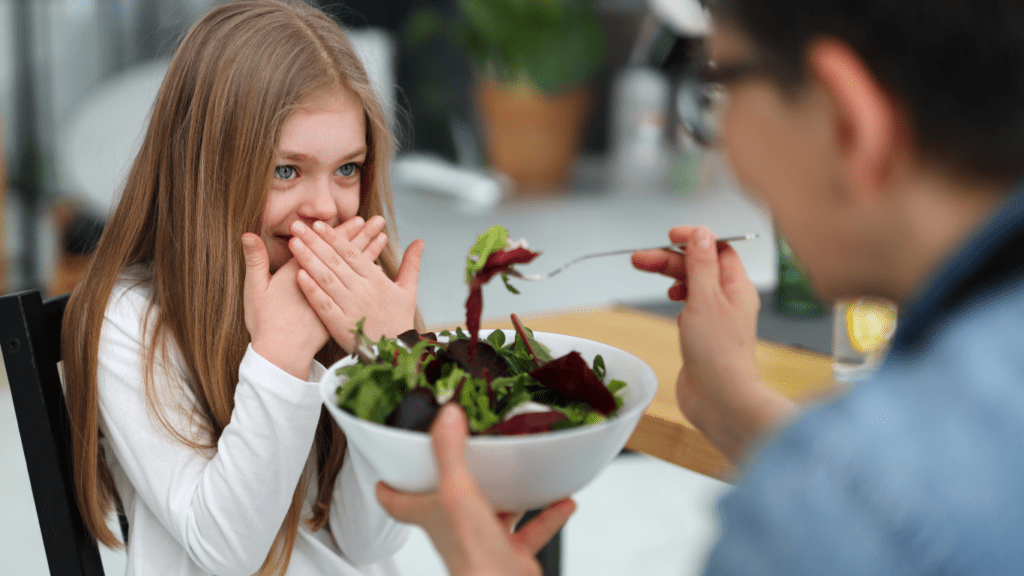Understanding Why Kids Dislike Vegetables
Vegetables often don’t appeal to kids for various reasons. By identifying these reasons, parents can develop strategies to make veggies more attractive.
The Role of Taste Preferences
- Kids have more taste buds than adults, making bitter flavors more intense.
- Vegetables like broccoli and Brussels sprouts have glucosinolates, which can taste bitter.
- Introducing milder veggies first, like carrots or peas, can help build a tolerance.
- Pairing veggies with familiar flavors also works well.
For instance, adding a small amount of cheese or a favorite dip can reduce aversion to the taste.
Textures and Colors Impact
The texture and color of vegetables can affect kids’ willingness to eat them. Vegetables with fibrous textures, like celery or kale, are often less appealing. Cooking methods can alter these textures.
For instance, steaming vegetables can make them softer and easier to chew. Bright colors can also be off-putting, especially if they contrast sharply with other foods on the plate.
Arranging veggies in a fun and visually appealing way can make them more enticing. For example, creating veggie art or using cookie cutters to shape vegetables into fun forms can capture kids’ interest.
Creative Cooking Methods to Increase Vegetable Intake
Introducing creative cooking methods can make vegetables more enticing for kids. By involving kids in the kitchen and making vegetables more appealing, mealtime becomes a fun and educational experience.
Involve Kids in Cooking
Inviting kids to participate in meal preparation can increase their interest in vegetables. I find that giving kids simple tasks like washing veggies, tearing lettuce, or stirring ingredients fosters a sense of ownership and pride in the meal they’re creating.
This engagement often translates to a willingness to taste and enjoy the vegetables they’ve helped prepare.
Encouraging kids to choose their vegetables during grocery shopping or from the garden boosts their excitement. When they’re allowed to pick their favorites, they feel more invested in the meal.
Additionally, using age-appropriate utensils and safe cooking tools makes the process enjoyable and safe, stimulating their curiosity and culinary skills.
Make Vegetables More Appealing
Transforming the presentation of vegetables can make them more attractive to kids. I like to use vibrant, colorful vegetables to create visually appealing dishes. For instance, arranging veggie sticks like carrots, bell peppers, and cucumbers into fun shapes or patterns can spark interest.
Incorporating vegetables into familiar dishes can also make them more palatable.
- blending spinach into smoothies
- adding grated zucchini to muffins
- topping pizzas with colorful veggies
Integrates them into foods kids already love. This seamless inclusion helps normalize vegetable consumption without making it feel forced.
Additionally, experimenting with different cooking techniques can enhance the flavor and texture of vegetables. Roasting vegetables like sweet potatoes and Brussels sprouts can bring out their natural sweetness, while lightly steaming broccoli or green beans can retain their crunch.
By presenting vegetables in various ways, kids can discover their preferred tastes and textures, ultimately leading to increased vegetable intake.
Educational Approaches to Promote Healthy Eating

Educating kids about the importance of vegetables can make a significant difference. By using creative educational approaches, you can instill lasting healthy eating habits.
Teach About Nutritional Benefits
Kids often respond positively when they understand the “why” behind actions. Discuss the specific nutrients found in vegetables and their benefits. For example, explain that carrots contain vitamin A, which supports healthy vision.
Use simple, relatable terms; instead of “antioxidants,” say “nutrients that help your body stay strong and fight sickness.” Share fun facts to spark interest. Did you know spinach has more iron than most other vegetables? Use authoritative sources like USDA and NIH for accurate information.
Fun and Interactive Learning Activities
Make learning about vegetables interactive. Create games that involve identifying different vegetables or matching them with their benefits. Use coloring books featuring various vegetables and their health benefits.
Engage kids in gardening by planting a small vegetable garden together. This provides hands-on experience with how food grows. Organize taste tests where kids can try different veggies prepared in various ways.
Reward them with stickers or small prizes to keep them motivated. Use positive reinforcement to build their interest and willingness to try new vegetables.
Leading by Example
Parents significantly influence a child’s eating habits. Demonstrating positive behavior around vegetables helps engrain these habits in kids.
Share Meals Together
Family meals present opportunities to model healthy eating. When I eat vegetables regularly, my kids see this behavior as normal. Studies from the Journal of Nutrition Education and Behavior indicate that children who eat with their family consume more fruits and vegetables.
This practice encourages dialogue about food choices, making mealtime educational and bonding.
Show Enthusiasm for Vegetables
My attitude towards vegetables impacts my kids’ perceptions. I express excitement about trying new vegetables and share positive experiences about their flavors and benefits.
According to the American Journal of Clinical Nutrition, parents who show enjoyment while eating vegetables increase their children’s willingness to try them. Enthusiasm makes vegetables appealing, transforming them from a chore into an enjoyable part of meals.

 Cynthian Holleyori is a skilled article writer who has been integral to the development of Toddler Health Roll. Her deep understanding of child health and development is evident in her well-researched and practical articles, which provide parents with essential guidance on raising healthy toddlers. Cynthian's contributions have significantly shaped the platform, ensuring that it addresses the most pressing concerns of parents and caregivers.
Beyond her expertise in toddler health and nutrition, Cynthian also delves into the mental and emotional well-being of young children. She offers valuable parenting strategies that help families foster a nurturing and supportive environment for their toddlers. Her dedication to building Toddler Health Roll has made it a trusted and comprehensive resource for parents committed to their children's growth and happiness.
Cynthian Holleyori is a skilled article writer who has been integral to the development of Toddler Health Roll. Her deep understanding of child health and development is evident in her well-researched and practical articles, which provide parents with essential guidance on raising healthy toddlers. Cynthian's contributions have significantly shaped the platform, ensuring that it addresses the most pressing concerns of parents and caregivers.
Beyond her expertise in toddler health and nutrition, Cynthian also delves into the mental and emotional well-being of young children. She offers valuable parenting strategies that help families foster a nurturing and supportive environment for their toddlers. Her dedication to building Toddler Health Roll has made it a trusted and comprehensive resource for parents committed to their children's growth and happiness.
